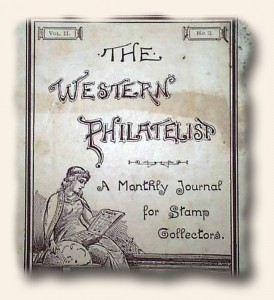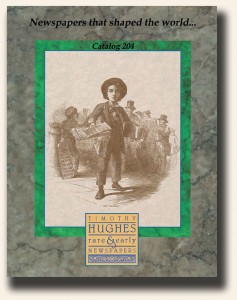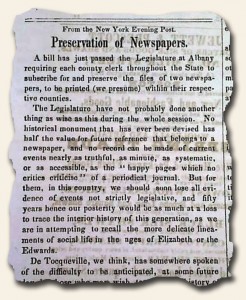Historic newspapers… entering on the ground floor of a collectible…
September 30, 2013 by TimHughes · 2 Comments
 In the world of collectables, early newspapers by no means rank among the most well-known of hobbies. In fact most would be surprised that it even is a hobby. Who knows anyone who collects early newspapers?
In the world of collectables, early newspapers by no means rank among the most well-known of hobbies. In fact most would be surprised that it even is a hobby. Who knows anyone who collects early newspapers?
That was exactly my thought nearly 40 years ago. Having been a coin collector since I was a kid, I knew that hobby well. I knew it well enough to recognize that no bargains could be had for the truly rare coins. Coin collecting was, and is, a well exploited hobby. The number of serious collectors must run in the hundreds of thousands with a proportionate number of dealers who make a living selling coins. So as a youngster with only grass-cutting money in my pocket, it didn’t take long to become frustrated when trying to find the last few desirable coins to fill out a set. I simply could not afford them. Everyone knew they were rare, and with more people wanting them than inventory allowed, prices were beyond my reach.
I liked collecting and I wanted a hobby that dealt with history. Holding a coin minted during the time when Lincoln was President, or when Indian battles were still raging on the Plains, intrigued me. I felt like I was touching history. But I needed a collectable that was yet to be exploited. One which few people were involved in. More importantly, one where I could hope to amass a reasonably nice collection without breaking the bank.
 So it was by accident that while browsing through a local flea market that I came across a Philadelphia newspaper from 1846. I was intrigued, not only by the price–$3—but by what I would get. Quickly my mind ran through the host of various coins from 1846 which would require more than ten times the price tag, and what do you get but a hunk of medal with a date & an image of a dead President? A coin could be fully examined in seconds. But this 1846 newspaper would take half an hour to absorb. So $3 exchanged hands and the newspaper was mine.
So it was by accident that while browsing through a local flea market that I came across a Philadelphia newspaper from 1846. I was intrigued, not only by the price–$3—but by what I would get. Quickly my mind ran through the host of various coins from 1846 which would require more than ten times the price tag, and what do you get but a hunk of medal with a date & an image of a dead President? A coin could be fully examined in seconds. But this 1846 newspaper would take half an hour to absorb. So $3 exchanged hands and the newspaper was mine.
Handling this newspaper was better than touching history. Yes, someone in 1846 held this newspaper in their hands, just like coins of the era, but this collectable actually CONTAINED history. News of the day, including events of the Mexican-American War, were within its four pages. Political reports from the term of James K. Polk were scattered throughout. Even the advertisements were fascinating.
I was hooked. The coin collection went on a shelf and I pursued whatever old newspaper I could find. It didn’t take long to discover a whole new world of collectables. Better yet, because so few people were collecting old newspapers prices seemed such a bargain compared to what coins or stamps or any other collectable with similar rarity would cost. I was convinced I got in on the ground floor.
As the years passed my hobby turned into a business catering to a niche market. At best I would suspect there are less than 2000 serious collectors of rare newspapers. Compare that number to the world of stamps, coins, books, or autographs, which hundreds of thousands consider their hobby.
 A hobby still yet to be discovered by the collecting world, prices remain attractive for the most modest of budgets. Consider that a genuine New York Times in very nice condition from 1863 with front page Civil War reports sells for less than $30. Or consider that a genuine London Gazette from 1680—a 330+ year old newspaper—is available for under $50. Of course content certainly drives interest and price so a newspaper reporting the Battle of Gettysburg can exceed $500, while the same in a Confederate title (much more rare) could be triple the price. But still, genuine issues covering the War of 1812 sell for $25; newspapers with Indian battles are under $35; issues with baseball reports from the 1880‘s can be had for $25; newspapers from during the administration of George Washington for $45. Is there a hobby where genuine items of comparable vintage are at comparable prices? Certainly not.
A hobby still yet to be discovered by the collecting world, prices remain attractive for the most modest of budgets. Consider that a genuine New York Times in very nice condition from 1863 with front page Civil War reports sells for less than $30. Or consider that a genuine London Gazette from 1680—a 330+ year old newspaper—is available for under $50. Of course content certainly drives interest and price so a newspaper reporting the Battle of Gettysburg can exceed $500, while the same in a Confederate title (much more rare) could be triple the price. But still, genuine issues covering the War of 1812 sell for $25; newspapers with Indian battles are under $35; issues with baseball reports from the 1880‘s can be had for $25; newspapers from during the administration of George Washington for $45. Is there a hobby where genuine items of comparable vintage are at comparable prices? Certainly not.
Rare newspaper collecting is a fascinating world which awaits any historical hobbyist. Whatever event or era in history intrigues, newspapers covered those events. From the Great Plague of London in 1666, to reports of pirates Blackbeard and Capt. Kidd, to the French & Indian War, the Revolutionary War, the Lewis & Clark Expedition, the Texas War for Independence, every presidential election & inauguration (and death), the outlaws of the West—you name it. Newspapers exist which document those occurrences and every other transforming event in American & world history.
Don’t just touch history with your hobby. Read history from the very day it was reported. You, too, will be hooked on a hobby you never knew existed.
Top ten battles of the Civil War… Just for fun…
August 14, 2013 by GuyHeilenman · 1 Comment
 A common way to collect historic newspapers is to assemble reports regarding various “top ten” lists. In the past, we have explored several such lists:
A common way to collect historic newspapers is to assemble reports regarding various “top ten” lists. In the past, we have explored several such lists:
When it comes to the Civil War (one of the most popular targets within the collectible community), “top tens” can take on various forms: Top ten noteworthy Generals, top ten most impacting events, top ten naval battles, top ten events/causes for the war, etc. In this vein, shown below are various links focused on top ten battles. Which were the most important? Opinions certainly will vary… which is why no two collections are the same. As an added bonus, how about exploring the top ten “under the radar” battles which do not typically make a top ten list? We’d love to have input.
Top 10 Battles of the Civil War – by Charles Gromley on Prezi
The Ten Costliest Battles of the Civil War
Top 10 Civil War Sites
Ten Bloodiest Civil War Battles
Top ten battles in civil war – WikiAnswers
Civil War Top 10 Lists
The Civil War in newspapers…
April 29, 2013 by TimHughes · 1 Comment
Could there be a period in American history which fascinates and intrigues more than the Civil War? As we celebrate the 150th anniversary of the battle between the North and the South, collecting interest in genuine newspapers which reported the news as it was happening, remains strong among the relatively small number of rare newspaper collectors. Any visit to a Civil War collector’s show will give evidence to the high prices of genuine memorabilia, from guns to uniforms to every bit and scrap of war-related material a collector might desire. But newspapers remain a very welcomed low-priced option, perhaps largely because they have yet to be discovered by majority of Civil War collectors.
But that has always been the case with this hobby, regardless of the time period. Rare newspaper have always remained relatively unknown in the world of historical collectables—a reality which continues to amaze—but its consequence has provided one of the benefits of those who enjoy the hobby: low prices. Across the entire spectrum of collectables, be they coins, stamps, furniture, books, autographs, toys—you name it–items of comparable age to newspapers are much higher than newspapers.
And what a world is available to the Civil War collector who discovers rare newspapers. You name the battle or political event that happened from 1861 to 1865 and it will be found in a newspaper of the day. And this hobby allows a collection to showcase not just the events of the war but the lead-up to the conflict between the states, as the issue of slavery and the troubling relationship between the Northern and Southern states making news for more than a decade before the outbreak of war.
From the Battle of Fort Sumter to the assassination of Abraham Lincoln, a collector can create a notable collection of newspapers as large or small as their budget will allow. Some might focus on the top ten most significant battles of the Civil War (see previous post) and include newspapers with accounts of Fort Sumter, First and Second Bull Run (Manassas), Hampton Roads (the Monitor vs. the Merrimac), Shiloh (Pittsburg Landing), capture of New Orleans, Antietam, Gettysburg, Vicksburg, Chickamauga, fall of Atlanta, Savannah and Richmond as well as the surrender of General Lee to U.S. Grant. Wikipedia offers an excellent and very inclusive list of all the battles of the Civil War which can be used as a checklist for the collector seeking the most notable events of the war.
Typically daily newspapers have war reports on the front page with additional news on inside pages as well, and a select few included graphics. The “New York Times”, “New York Tribune” “New York Herald” and the “Philadelphia Inquirer” are—in my opinion—the “big 4” titles of the war, as they more than most printed Civil War maps and other war-related graphics on their front pages. Such issues remain favorites for framing and display.
Not to be overlooked are the political events and speeches which were perhaps more significant than the battles, including the election and inauguration of Abraham Lincoln, the Emancipation Proclamation and the Gettysburg Address. All events appeared in newspapers within a day of their happening.
Yet another area of focus for various collectors is the gathering of contemporary reports surrounding certain historic figures such as Abraham Lincoln, Robert E. Lee, Ulysses S. Grant, “Stonewall” Jackson, George Meade, James Longstreet, William Sherman, Jefferson Davis, Ambrose Burnside, Nathan B. Forrest, Colonel Robert Shaw, John Hunt Morgan (and his raiders), to name a few. Textbooks simply cannot capture the essence of these noteworthy individuals in the same way newspapers can.
Some collectors might focus on the Civil War from the Confederate perspective as newspapers from the Southern state are available, albeit more rare, and offer an interesting perspective on the events of the war. Issues from Richmond, the capital of the Confederacy, offer some of the best coverage of the war as all news eventually found its way to Richmond. And the editorials offer fascinating reading in the “Daily Richmond Examiner” or the “Daily Dispatch”. Charleston newspapers also offer great coverage, after all the war began in its harbor. The “Charleston Daily Courier” was one of the best, and one of but a few Southern newspapers which printed in the masthead “Confederate States of America”. Venturing beyond the more “common” of the Confederate titles, newspapers from other states are available, a few of the more accessible being the “Daily Progress” (from Raleigh) and the “Louisville Daily Courier” from Kentucky. The “Daily Memphis Appeal” is an intriguing title, as during its Civil War history it was chased by the Yankees out of Memphis and published in 8 other Confederate cities before succumbing in the final weeks of the Civil War.
A “Confederate” newspaper from the North might seem like a oxymoron, but “The Crisis” from Columbus, Ohio, was an intriguing newspaper by a copperhead publisher who was very much opposed to the Lincoln administration and strongly supported the Confederate effort believing that slavery could not be prohibited by law.
One cannot mention newspapers of the Civil War without discussing “Harper’s Weekly”, the illustrated newspaper which put all the action, drama and cruelty of war into the homes of every American. For the first time, citizens were able to see what their leaders looked like, as an abundance of portraits of the Civil War officers appeared throughout the war years, not to mention the great wealth of battle scenes and city views not found elsewhere during the Civil War. Not to be outdone by the Yankees, the Confederates created their own version of “Harper’s Weekly”, titled the “Southern Illustrated News” published in Richmond, but it was a poor imitation at best. It’s lack of success resulted in a considerably smaller circulation and obviously more rare title for collectors today.
Whatever your interest in the Civil War, collectible newspapers have much to offer. With prices relatively low for 150 year old items and containing virtually every event which happened during that fascinating era, a notable collection can be amassed which can be enjoyed and admired without breaking the bank. A fascinating world awaits those who discover this interesting collectible.
Beyond the historic headline…
November 1, 2012 by TimHughes · Leave a Comment
 “Newspapers that shaped the world…“
“Newspapers that shaped the world…“
Some of the better & more fascinating items found in old newspapers are not the most historic or significant, but rather the casual appearance of seemingly innocuous reports which excite collecting interest beyond the historic headline or dramatic presentation which are the more usual draw.
Much of what intrigues collectors can be lost within the body of reports, yet they tell a story of their own, such as the patriotic fervor of some colonist during the Revolutionary War. I recall an issue of the Edinburgh Evening Courant of June, 1776 reporting on American soldiers: “…Their uniform is a dark grey coarse linen frock, which covers the whole body…with the words, ‘Death or Liberty’ marked in large red letters on the right sleeve; and many of them are so enthusiastic as to have them marked with their own blood…”. This report is almost lost on page 3 yet its message is very telling of the spirit which caused the Americans to win the war against a world power despite insurmountable odds.
Some reports are fascinating by their bias. A Richmond newspaper of July, 1863 reporting on the Battle of Gettysburg notes: “…The Confederates did not gain a victory, neither did the enemy. He succeeded in defending himself & we failed in some portions of an attack…We killed more of the enemy than we lost; we took very many more prisoners than lost. The Confederate army did not leave the enemy until it had tried every link of his armour…” Another newspaper notes: “ ..Information, certainly authentic, is in the hands of the Government, which leaves no doubt of the safety & triumph of the noble army. General Lee was victorious in all the combats which have taken place. He has been engaged with the whole force of the United States & has broken its backbone…”, Perhaps the most extraordinary example of optimism appeared in the Richmond Examiner of July 25: “…The result was not a defeat, it was not a loss; it was only not a victory…It was little else than a disappointment of extraordinary expectations…”. What a precious statement as an example of Confederate optimism.
Other little gems were very prophetic in their reporting, particularly when read with an historic perspective. A Scottish newspaper from 1775 sensed a lasting war with America as it reflected on the Battle of Bunker: “…The mischiefs which have already arisen & the greater calamities which are threatened from the unnatural war excited in America…It is impossible we can see, without the utmost alarm, preparations making for the prosecution of an expensive & ruinous war with our own Colonies…”. Some can be very recent, like the New York Times comment on rookie Mickey Mantle in 1951: “…Mantle, who gives every promise of developing into an outstanding baseball star, was ordered to report to his draft board next Wednesday…” An editorial comment in the Army & Navy Journal just after the Gettysburg Address opined: “…a dedicatory speech by President Lincoln, which we give in full, as decidedly the best feature of the occasion, as well as one of the most felicitous utterances of its author.” How true.
Some were prophetic even when the reports were simply wrong, like the Illustrated American article of 1898 reporting on “A New Flying Machine That Flies”–five years before the Wright brothers–when it said: “…It is impossible to imagine without terror the day when these mechanical birds, these flying apparitions, will be able to rain upon armies, hostile towns and escalating parties most deadly and most destructive explosives…”. How true it would become.
There can be much to be found in newspapers beyond the headline. What a thrill it is to discover such hidden gems; reports that have escaped hundreds of years of history only to rediscovered with new-found relevance today. Such are just some of the joys of collecting early newspapers.
Please enjoy: “Newspapers that shaped the world…“
Concern for preserving newspapers in 1849…
September 11, 2012 by TimHughes · 1 Comment
 Over 160 years ago the New York legislature had the foresight to be concerned about the future holdings of newspapers, and more importantly the loss of the unique perspective of history which can only be obtained through newspapers of the day. Their cause remains as relevant today as it was in 1849.
Over 160 years ago the New York legislature had the foresight to be concerned about the future holdings of newspapers, and more importantly the loss of the unique perspective of history which can only be obtained through newspapers of the day. Their cause remains as relevant today as it was in 1849.
The photos show the entire editorial as found in the “Vermont Chronicle” of Windsor, May 2, 1849, but portions include: “…No historical monument that has ever been devised has half the value for future reference that belongs to a newspaper, & no record can be made of current events nearly as truthful, as minute, as systematic, or as accessible, as the ‘happy pages which no critics criticise’ of a periodical journal…” and “…De Tocqueville…has somewhere spoken of the difficulty to be anticipated at some future day of those who may wish to trace the history of our people for the want of durable monuments or records of their current life & achievements…that the newspaper was almost our only historical repository & that was usually destroyed as soon as its contents were glanced at…” and much more.
A fascinating article on the need to preserve newspapers; something which all of us in this hobby continue to do in some small way.
The entire text of this intriguing article may be viewed at: “Vermont Chronicle” of Windsor, May 2, 1849
The end of the world… false alarm…
August 6, 2011 by GuyHeilenman · Leave a Comment
 A few years ago several collectors contacted us wondering if the end of the Rare & Early Newspapers collectible was at hand. They had just received news about Google’s newspaper digitizing project and wondered if this would lead to an end in people wanting to collect historic newspapers. “Might this be the end of the old newspaper’s collectible world?” We tried to reassure them them that collecting the actual newspaper from the day it was 1st printed/read as compared to reading digitized versions is akin to eating an ice-cream sundae rather than looking at a picture of one. No matter how perfect the picture of the sundae reproduces the look of an actual one, it can never compare to the real deal. Apparently, time has proven this to be so. 2011 brought news from Google announcing the end of the digitizing project. The date of the announcement is rather ironic. Please read:
A few years ago several collectors contacted us wondering if the end of the Rare & Early Newspapers collectible was at hand. They had just received news about Google’s newspaper digitizing project and wondered if this would lead to an end in people wanting to collect historic newspapers. “Might this be the end of the old newspaper’s collectible world?” We tried to reassure them them that collecting the actual newspaper from the day it was 1st printed/read as compared to reading digitized versions is akin to eating an ice-cream sundae rather than looking at a picture of one. No matter how perfect the picture of the sundae reproduces the look of an actual one, it can never compare to the real deal. Apparently, time has proven this to be so. 2011 brought news from Google announcing the end of the digitizing project. The date of the announcement is rather ironic. Please read:
Google Announces End Of Newspaper Digitizing Project
🙂 🙂 🙂
First newspapers in Ohio…
March 21, 2011 by TimHughes · Leave a Comment
 Ohio was still part of the vast Northwest Territory when the first newspaper in present-day Ohio was published in 1793. The date was November 9 and William Maxwell’s newspaper the “Centinel of the North-Western Territory” was the first product of the printing press anywhere north of the Ohio River & west of the Allegheny & Blue Ridge mountains. The city of publication was Cincinnati, but just a few years earlier it’s name had changed from “Losantiville”. The newspaper would continue until June of 1796, although records show the newspaper was sold to Edmund Freeman in 1796 who changed the name to “Freeman’s Journal“. Records show, however, that it did not publish until July of 1800 and lasted less then 6 months.
Ohio was still part of the vast Northwest Territory when the first newspaper in present-day Ohio was published in 1793. The date was November 9 and William Maxwell’s newspaper the “Centinel of the North-Western Territory” was the first product of the printing press anywhere north of the Ohio River & west of the Allegheny & Blue Ridge mountains. The city of publication was Cincinnati, but just a few years earlier it’s name had changed from “Losantiville”. The newspaper would continue until June of 1796, although records show the newspaper was sold to Edmund Freeman in 1796 who changed the name to “Freeman’s Journal“. Records show, however, that it did not publish until July of 1800 and lasted less then 6 months.
The second newspaper published in Ohio was also done in Cincinnati, called the “Western Spy and Hamilton Gazette“, begun in May of 1799 and lasting till the end of 1822. Only one other pre-statehood (1803) newspaper published in Ohio, being the “Scioto Gazette” published in Chillicothe, it beginning January 8, 1801 and lasting through the end of 1803.
A collector sells bound volumes in 1878…
December 11, 2010 by TimHughes · Leave a Comment
This advertisement appeared in the “Scientific American” issue of June 22, 1878, noting a collector who has various bound volumes of the title, selling for $1 each. How prices have changed.
My collecting story… Graham Dukes…
November 15, 2010 by GuyHeilenman · Leave a Comment
I have been collecting newspapers longer than most fellow enthusiasts, beginning when I was at school in England in 1943. My father went into a small second-hand shop and noticed that the owner, who sold candlesticks, old dinner plates and suchlike, was wrapping up the items in copies of the London evening “Star” for 1818, that he was tearing out of a bound volume. There were about 150 papers left and my father, who was well aware of my budding historical interest, bought the whole volume for threepence (10c).
From there I continued myself, often picking up items from shopkeepers who had no idea what they were. Nearly 70 years later, with several thousand items in store, (particularly London national papers, but also items from many other countries) some of my prize items, going back to the earlier sixteenth century, are still those that I found in the English back streets during my time as a schoolboy and later as a university student!
Graham Dukes
New discovery… Who knows what one might find?
November 8, 2010 by GuyHeilenman · Leave a Comment
We’ve often mentioned that one of the pleasures of the Rare & Early newspaper collecting hobby is finding unforeseen historical nuggets buried deep within the pages of newspapers… just waiting to be unearthed.  This was recently brought to the surface again by a collector/history teacher who purchases 19th century wholesale lots (undescribed as to content) for his students and for personal use . His note is as follows:
This was recently brought to the surface again by a collector/history teacher who purchases 19th century wholesale lots (undescribed as to content) for his students and for personal use . His note is as follows:
This paper (from a wholesale lot) had a reference to a house vote for the “relief” of Susan Decatur, wife of naval hero Stephen Decatur. She had inherited $75,000 from her husband, who was killed in a duel in 1820. This is the equivalent of $1.4 million today. The bill was defeated. One of the nays was cast by Congressman Crockett (David). Minor, but priceless info. Your company does more good than you know.
Feel free to share your own discoveries with the collecting community.


